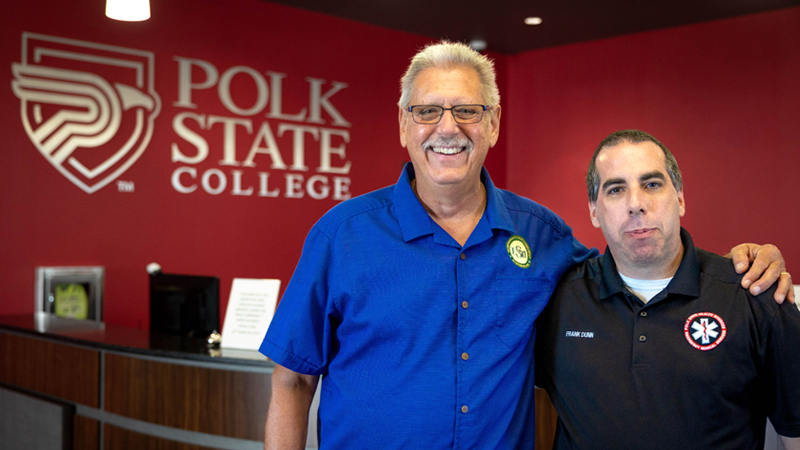Polk State paramedic instructor celebrates milestone anniversary of exclusive program

For 25 years, students who have gone through Polk State College’s Paramedic Program have received a certification offered by no other paramedic program in the state. Leading this training for its entirety has been Rick Stilp, who was recently honored for his quarter-century of instruction at the College.
Stilp started the Hazmat Medic Program in 1984 when he became a charter member of the Orlando Fire Department’s Hazardous Materials Team. Tasked with developing the program and training fellow Orlando paramedics, Stilp’s Hazmat Medic Program was born. He’s been teaching the three-day course across the state for nearly four decades, but for those going through paramedic programs, it is only offered at Polk State.
“Right here at Polk State is the only paramedic program in the entire state that has a toxicology portion and for 25 years, it’s been the only one,” Stilp said. “If paramedics graduate from any other college and they want this program, they have to go to a separate class to get it. (Polk State students) get it in this program.”
Stilp began teaching the course in 1997 for Don Guilette, Polk State’s program director for Emergency Medical Services at the time.
“The fact that I’ve trained 25 years of Polk County students in the Paramedic Program in hazmat and toxicology is pretty cool to me. The funny thing is I run across people who I taught when they were first starting who are now retiring,” Stilp said. “That’s how long I’ve been teaching.”
Those who complete the program receive a Hazmat Medical Certification. Polk State’s current program director, Frank Dunn, went through the program himself.
“His knowledge and experience are invaluable,” Dunn said. “When he teaches the class, he has so many helpful stories and hands-on experience that you can’t get from a textbook. He just knows and means so much and we’re grateful to have him.”
Stilp joined the Orlando Fire Department as a firefighter in 1976 and became a paramedic two years later. His inspiration to enter the field came from a popular television show called, “Emergency!” which aired from 1972 to 1977.
For nine years in the 1980s and early 1990s, he doubled as a nurse at Winter Haven Hospital. Stilp retired from the Orlando Fire Department as a district chief in 1999 before spending one year as chief at the St. Cloud Fire Department, beginning in 2019.
Why it Matters
Stilp’s Hazmat Medic program gives an in-depth look into an ever-evolving subject matter – toxicology.
“Paramedic curriculum focuses on serious diseases, heart and respiratory issues, and trauma,” he said. “But they don’t talk a whole lot about toxicology. The program I teach really gets into the other stuff that isn’t covered in a typical paramedic program.”
Suicide and suicide attempts of individuals close to Stilp have driven him to educate paramedics about dangerous chemicals.
According to the World Health Organization, ingesting pesticides is now the most common method for committing suicide worldwide. In the U.S., ingesting sodium nitrate is becoming a more common method.
“Suicides are topping out at an all-time high. More and more people are turning to chemicals,” he explained. “The most rewarding thing is when a student calls me up and says, ‘I recognized this poisoning, and I saved a life.’ It doesn’t matter how many years you teach it; if it saves one life, it’s worth it. It’s absolutely what keeps me going.”
Stilp has written books, and textbooks and has been featured in medical journals. Stilp’s latest textbook, “Emergency Medical Response to Hazardous Materials Incidents,” which was co-authored by Armando Bevelacqua addressed how to treat each type of substance intake for young children, adults, and dogs.
“We had paramedics who were K-9 handlers,” Stilp said. “Dogs get into cyanide and all kinds of other substances. People want to know how to treat their dogs. We worked with veterinarians. These are the only protocols for dogs in the entire country.”
In addition to his work as a firefighter, paramedic, and a nurse, Stilp was once the director of the paramedic program at Valencia College. Stilp holds two associate degrees from Valencia College, a bachelor’s from the University of Central Florida and a master’s in business from Webster University. He also served on the committee that helped develop the hazmat program for the National Fire Academy.
His expertise also contributes to the success of the Polk State Emergency Medical Services Program. Polk State’s EMT and paramedic graduates boast 100% pass rates on the National Registry of Emergency Medical Technicians certification exams, compared to national average pass rates of 69% and 71%, respectively, in 2021.
The Polk State Paramedic Program’s application period will be open from July 1 through July 31. More information and the application are available here.
“It’s the actions of EMTs and paramedics that save lives,” Stilp said. “Seasoned paramedics, to me, are brilliant people. They save lives every day just by intuition.”
A Paramedic at Heart
Now 69 years old, Stilp said he is looking to “slow down” when it comes to teaching. Stilp’s passion for saving lives is evident, but he also has a passion for classic cars. He’s the owner of a 1928 Ford Model A Sedan Delivery, 1962 Ford Econoline pickup, 1965 Ford Mustang GTE, 1951 Mercury pickup, and a 1932 Ford Roadster.
Including two stepdaughters, Stilp is a father of five with eight grandchildren, one great grandchild, and another on the way. Stilp’s only son, Jake Stilp, a 13-year veteran of the Orlando Fire Department, is a fire engineer and paramedic.
Jake, he said, was once a nickname commonly given to rookie firefighters and emergency medical technicians. Stilp’s great grandson is also named Jake. Stilp’s grandson, Christopher Presser, is currently in the fire academy.
“He will be a third-generation firefighter,” Stilp said. “I love firefighters. I think that’s pretty cool.”

